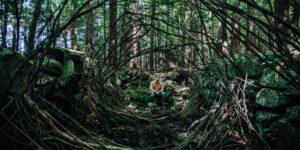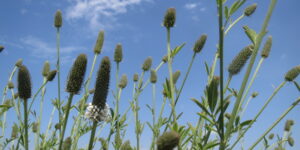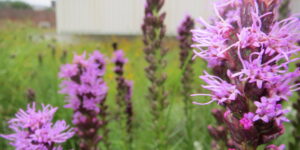Dan Snow wrote a few days ago to let me know the proposal we submitted for the stone and medicinal herb installation at the Central Oregon Community College was accepted! We’ll be going to Bend, Oregon to install it in August.
Here is the text for the original proposal – written by Dan and me:
My desire is to assemble a collection of unique stone
features, set amidst plantings of medicinal herbs and
flowers, to contrast the surrounding hardscape and compliment
the architectural elements of the building.
features, set amidst plantings of medicinal herbs and
flowers, to contrast the surrounding hardscape and compliment
the architectural elements of the building.
Two naturally smooth-contoured stones, 1-3 tons in size,
will rest on cribbing constructed of rough-split, quarried
stones. The sculptural features will seem to float above
plaza surfaces, and also interact with the existing stone
wall by coming into direct physical contact with it at
precise points. One of the natural stones, and many of
the quarried stones, will lend themselves to seating.
The constructed stone elements, within the total installation,
will have singular personalities of their own
owing to their one-of-a-kind characteristics. The linear
geometry and dynamic tension of the cribbing stones
will cradle the cool serenity of the boulders’ softly-worn
surfaces.
will rest on cribbing constructed of rough-split, quarried
stones. The sculptural features will seem to float above
plaza surfaces, and also interact with the existing stone
wall by coming into direct physical contact with it at
precise points. One of the natural stones, and many of
the quarried stones, will lend themselves to seating.
The constructed stone elements, within the total installation,
will have singular personalities of their own
owing to their one-of-a-kind characteristics. The linear
geometry and dynamic tension of the cribbing stones
will cradle the cool serenity of the boulders’ softly-worn
surfaces.
The Hardiness Zone 6 plants chosen for this installation
all have medicinal properties. The plantings are located
within areas already designated for a mix of 4” plugs
and plant seed mix in the plan set for the building. The
warm microclimate created by the site’s southwest exposure
and the profusion of stone surfaces to store thermal
gain will help to sustain the plants. Incorporating healing
plants into the walk-way extends the mission of the
science library beyond its walls and provides a reflective
metaphor for those passing by. As one ascends the steps
from the road to the library, the clinical uses of the
plants become more complex. At the level nearest the
road, are those plants most commonly used in folk medicine,
the middle level hosts plants that require a more
nuanced understanding for use, and those at the top are
the most powerful and demand a thorough comprehension
of use and manufacture.
all have medicinal properties. The plantings are located
within areas already designated for a mix of 4” plugs
and plant seed mix in the plan set for the building. The
warm microclimate created by the site’s southwest exposure
and the profusion of stone surfaces to store thermal
gain will help to sustain the plants. Incorporating healing
plants into the walk-way extends the mission of the
science library beyond its walls and provides a reflective
metaphor for those passing by. As one ascends the steps
from the road to the library, the clinical uses of the
plants become more complex. At the level nearest the
road, are those plants most commonly used in folk medicine,
the middle level hosts plants that require a more
nuanced understanding for use, and those at the top are
the most powerful and demand a thorough comprehension
of use and manufacture.
The integration of plant with the stone evolves at each
terrace level, as though in concert with a student’s
rising knowledge and understanding. At the lower level,
low-growing plants like lavender, thyme and California poppy
flourish in the beds beside the terrace. In the middle, taller
plants like elecampane and baptisia embrace the cribbing/
stone. And on the top of the terraces, the installation will be
completely integrated with plants as passionflower and codonopsis
vines twist along the crib-rails and over the feature
stone. An environment of ephemeral plants and eternal rocks
is a living metaphor for finding ones path to a profound
understanding of healing. Education is a transformative
experience. New-found awareness and resulting change will
become a reoccurring theme expressed by the sculpture in
each moment and over the span of years.
terrace level, as though in concert with a student’s
rising knowledge and understanding. At the lower level,
low-growing plants like lavender, thyme and California poppy
flourish in the beds beside the terrace. In the middle, taller
plants like elecampane and baptisia embrace the cribbing/
stone. And on the top of the terraces, the installation will be
completely integrated with plants as passionflower and codonopsis
vines twist along the crib-rails and over the feature
stone. An environment of ephemeral plants and eternal rocks
is a living metaphor for finding ones path to a profound
understanding of healing. Education is a transformative
experience. New-found awareness and resulting change will
become a reoccurring theme expressed by the sculpture in
each moment and over the span of years.
Plants create a dynamic relationship with the rock through
seasonal change, motion and texture. Springtime and summer
will see foliage growing and blooming, creating a cushioned
topography and leafy backdrop. In autumn, the skeletal
remains of stalks and vines will cast a web of shadows. In
winter, the feature stones will be capped with snow and the
voids under them turned to soft, white hollows. The look and
feel of the piece will change with the seasons.
seasonal change, motion and texture. Springtime and summer
will see foliage growing and blooming, creating a cushioned
topography and leafy backdrop. In autumn, the skeletal
remains of stalks and vines will cast a web of shadows. In
winter, the feature stones will be capped with snow and the
voids under them turned to soft, white hollows. The look and
feel of the piece will change with the seasons.
The sculpture will have an inviting presence, attracting the
viewer’s eye to explore its details of color, form and texture,
and at the same time, offer an overall sense of welcome to
those entering the building. The piece will offer surprises
upon first visit, something a little different with each repeated
viewing, and a feeling of grounded comfort to those
who pass by it every day.
viewer’s eye to explore its details of color, form and texture,
and at the same time, offer an overall sense of welcome to
those entering the building. The piece will offer surprises
upon first visit, something a little different with each repeated
viewing, and a feeling of grounded comfort to those
who pass by it every day.
Elements of the sculpture will present a variety of shapes
and sizes, creating compliments of scale within the piece
itself and with surrounding architectural features.
I see the building entrance area as a conduit for pedestrian
traffic, a meeting place, and an island of natural beauty. It’s
my hope that the plaza terraces, steps, walls, stone features
and plantings will merge and become one holistic, environmental
art experience.




